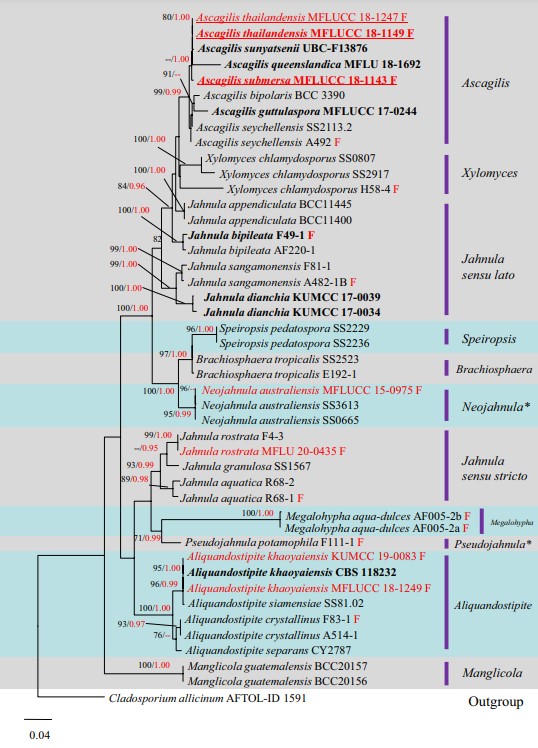Neojahnula australiensis (K.D. Hyde) W. Dong, H. Zhang & K.D. Hyde, comb. nov.
MycoBank number: MB 557899; Index Fungorum number: IF 557899; Facesoffungi number: FoF09241; Fig. 12
Basionym: Jahnula australiensis K.D. Hyde, Aust. Syst. Bot. 6(2): 161 (1993)
Freshwater distribution: Australia (Hyde 1993a), Brunei (Ho et al. 2001), China (Ho et al. 2001), Peru (Shearer et al. 2015), Thailand (Suetrong et al. 2011a; this study) USA (Raja et al. 2009b)
Saprobic on submerged wood. Sexual morph: Ascomata 80–110 μm high, 100–130 μm diam., scattered or gregarious, superficial, subglobose or lenticulate when compressed, black, membranous, with scarcely projecting papilla, ostiolate, with few hyaline to pale brown hyphae. Peridium thin, 5–10 μm thick, composed of one row of large, thin-walled, brown to dark brown cells of textura angularis. Pseudoparaphyses 3 μm diam., numerous, cellular, hypha-like, hyaline, sparsely septate. Asci 135–175 × 17–19 μm (x̄ = 155 × 17.5 μm, n = 5), 8-spored,
bitunicate, fissitunicate, cylindrical, sessile or short pedicel- late, with an ocular chamber and faint apical ring. Ascospores 23–27.5 × 6–7.5 μm (x̄ = 25.5 × 7 μm, n = 15), uni- to bi-seri- ate, elongate, ellipsoidal, tapering towards the apices, rounded at the base, brown, 1-septate, constricted at the septum, upper cell slightly wider than lower cell, guttulate, mostly curved, smooth, thin-walled, without sheath. Asexual morph: Undetermined.
Culture characteristics: On PDA, colony circular, reaching 20 mm in 25 days at 25 °C, reddish brown from above, dark brown to black from below, surface rough, with dense mycelium, fluffy, raised as a annulus around the margin, dry, edge entire.
Material examined: THAILAND, Prachuap Khiri Khan Province, on submerged wood in a stream, 30 July 2015, K.D. Hyde, 66D (MFLU 15-2711), living culture MFLUCC 15-0975.
Notes: Our collection MFLUCC 15-0975 clusters with two strains of Neojahnula australiensis (SS3613 and SS0665) with high bootstrap support (Fig. 14). SS3613 only has ITS and SS0665 only has SSU sequence data in GenBank, which are identical with MFLUCC 15-0975. The morphology of SS3613 and SS0665 cannot be compared as they were not provided in Prihatini et al. (2008) and Pang et al. (2002), respectively. The sequence data from ex-type strain of N. australiensis is lacking, but our collection MFLUCC 15-0975 has identical morphological characteristics with the holotype (BRIP 19208), except for longer asci (135–175 × 17–19 μm vs. 90–140 × 14–18 μm) (Hyde 1993a). Based on morphological characteristics and available sequence data, MFLUCC 15-0975 is identified as N. australiensis.

Fig. 12 Neojahnula aus- traliensis (MFLU 15-2711). a Ascomata on host surface. b Vertical section of ascoma. c Pseudoparaphyses. d Structure of peridium. e, f Bitunicate asci. g Ocular chamber and faint apical ring. h Ascospore. i, j Colony on PDA (up-front, down-reverse). Scale bars: b, e, f = 20 μm, c = 15 μm, d = 5 μm, g, h = 10 μm

Fig. 14 Phylogram generated from maximum likelihood analysis of combined LSU, SSU and ITS sequence data for species of Jahnulales. Bootstrap values for maximum likelihood equal to or greater than 70% and Bayesian posterior probabilities equal to or greater than 0.95 are placed near the branches as ML/BYPP. Newly generated sequences are in red and ex-type strains are in bold. The new species introduced in this study are indicated with underline. Freshwater strains are indicated with a red letter “F”. The tree is rooted to Cladosporium allicinum AFTOL-ID 1591 (Capnodiales)
